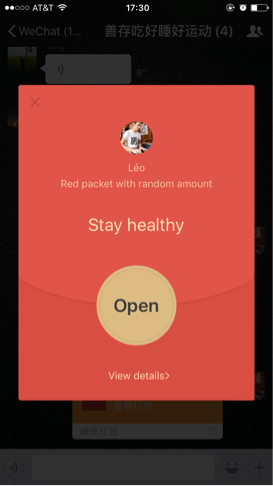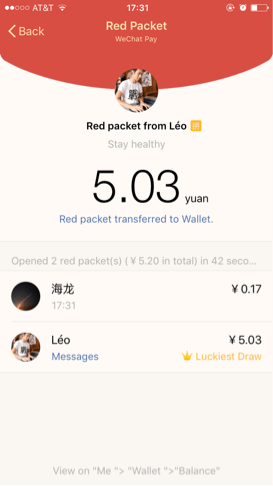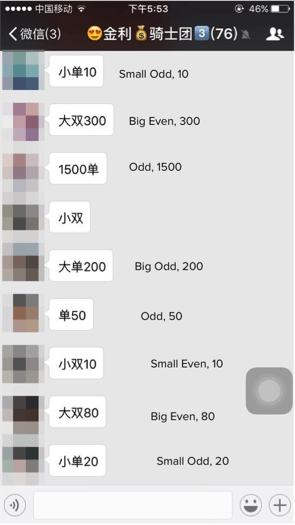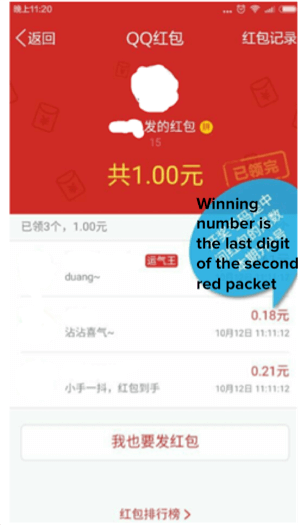
credit: Connie Chan/ a16z
Network effects — where a product or service becomes more valuable to its users as more people use it — are one of the key ways software businesses maintain a better product and more defensible market position. This is especially true of messaging apps like WeChat — which, as I’ve argued before, is not just a messaging app but is actually more of a portal, a platform, and a mobile operating system. However you label it, WeChat is an entire ecosystem in and of itself, especially as it’s used in Asia. This is largely enabled by the sheer amount of payments credentials attached to user accounts, which significantly reduces friction in transacting across the marketplace, both online and offline.
But how did WeChat resolve their “chicken-egg problem” — getting more users or more merchants on both sides of the marketplace without there being critical mass on either side at first? For getting the user side, it is no easier to type in your payment credentials into a messaging platform (for the first time) than it is to type it into a third-party merchant form to complete a transaction — no time is saved, no friction is removed. Similarly, for the merchant side of the marketplace, there is no incentive to dedicate marketing dollars and engineering resources to the platform in the first place if there’s not already an existing base of purchase-ready users. Unless you’re Apple with its credit-card ready iTunes, most messaging and other app platforms must work extra hard to get users to willingly share payment credentials. They have to convince the user that either he/she will soon purchase again on the platform, or that there is some other immediate benefit to setting up a digital wallet with them. Users have no incentive to do so otherwise.
Interestingly, WeChat resolved this issue without using one of the common strategies for solving chicken-egg problems. That’s because they had the advantage of a cultural meme — not something commerce-based but C2C social communication based — that compelled users to bind their payment credentials to their WeChat accounts: red envelopes. This meme not only helped WeChat convince over half of its China users to provide payment credentials, but also allowed them to do so at a very rapid pace. (Which, to be clear, is an example of viral growth not network effects. But the point is that this viral growth led to other network effects in the WeChat ecosystem).
Red envelopes were WeChat’s secret weapon in getting users to adopt mobile payments on their messaging platform, unlocking all subsequent transaction activity across their ecosystem.
What: Cultural memes as social communication
For cultural context: red envelopes (literally small, red paper envelopes) that contain cash gifts are given on special occasions like weddings, births, graduations, and the major holiday/ spring festival known as Chinese New Year — which is like Christmas and New Years combined for many in East Asia. Similar to sending a Christmas card, sending a friend a red envelope is like saying “best wishes!”.
To celebrate the Chinese New Year holiday in 2014, WeChat launched a P2P (peer-to-peer) payment feature called Lucky Money, later renamed Red Packets. Two years later, over 420M WeChat users sent 32B digital red envelopes over the six-day holiday — with peak usage coming in at 409K red envelopes sent per second. (To put this number in perspective: PayPal had 4.9B transactions worldwide for the entirety of 2015, including both mobile and desktop.)
Over 60M WeChat users in China continue to send Red Packets each day — not just on holidays — as they have now become their own form of social communication, similar to sending stickers or emoji.
How: Gaming as growth hack
By injecting gaming mechanics into its digital version of red packets from the get-go, WeChat helped make P2P payments a new form of social communication: Sending money no longer feels tacky but socially welcomed, with a message. (It is a messaging platform after all!). Equally important as accelerating the adoption of payments, these gaming mechanics also led to much higher usage of group chats.
When WeChat first launched Red Packets, it offered two basic options: send money to an individual or send money to a group of friends. Many users flocked to the latter option because the sender was allowed to specify not only the total gift amount and message, but also how many winners could claim a portion of the prize (with each amount randomized by WeChat). So for a group of, say, 50 members, the sender might only choose to give out 10 prizes — meaning only the first 10 members of the group who claim the prize get anything. This lottery-like feature sent recipients into a frenzy, because they would all “receive” the red envelope at the same time, have no idea how many people are allowed to win it, and so would race to claim Red Packets before the prize money ran out.
In a funny inversion not socially acceptable in real life, even senders can be winners online! Yes, really: someone who was sending money to others as a gift could actually receive back their own gift instead (as Leo below does).


So what’s the point you might ask? Receivers still feel goodwill from receiving a packet in the first place, even if it’s near empty. It is the act of sending the Red Packet that wins goodwill, not the amount sent. In fact, if the receiver draws a low amount, he/she will attribute it to luck. This cultural context enabled money to become more than just a transaction.
When: Timing marketing campaigns
Besides setting up the above viral effects with zero customer acquisition cost (CAC), another way the company markets its platform is through paid partnership and advertising campaigns. In 2015, WeChat parent company Tencent invested $8.1M USD to win the rights for CCTV’s (Chinese Central Television) national programming for the annual Spring Festival. Picture something like Dick Clark’s New Year’s Rockin’ Eve, but with 800M viewers, which is 7X the viewers of the Super Bowl.
In this one-time broadcast blast, WeChat advertisers (like Chevrolet, Huawei, etc.) gave away over $81M USD of digital money to 36M WeChat users who used the app to claim Red Packets while watching the show. Viewers would simply shake their phones at their TVs to try to grab an envelope full of free money. And then, right after the programming ended, WeChat distributed another $484M USD worth of Red Packet discount coupons that had been subsidized by third party sponsors. Rather than spread marketing dollars out over a long period of time, Tencent had asked those select advertising partners to funnel their dollars around this special event.
This concentrated combo of free cash and discounts worked, and worked well. This year, Alibaba did something similar for Alipay (only this time the CCTV rights were reportedly five times more expensive). Tencent didn’t win the bid, but then again it didn’t have to: During the mid-Autumn festival holiday in September 2015, only seven months after the WeChat CCTV campaign, 100M WeChat users sent Red Packets to friends and family — with no prompt or promotion from WeChat’s side.
Yet, WeChat continues to use cultural occasions and new games as opportunities to market and grow adoption of digital red envelopes. For example, in 2016, WeChat allowed users to obfuscate their photo posts in their WeChat Moments newsfeed (similar to a Facebook’s NewsFeed) so that friends who wanted to un-blur the photo had to send that user a Red Packet — essentially paying to unlock the photo. Open for less than a day, the campaign led to people posting 29M blurred photos.
Why: Intended and unintended consequences
The gameplay and promotions embedded in WeChat’s digital red envelopes illustrate the “growth hacks” they used to deliberately grow their network and ecosystem. Some of these tactics, which seem gimmicky at first glance, clearly accelerated the adoption of new features such as payments and group chats as well as opened up unexpected new engagement opportunities.
For payments: Today, over 300M WeChat users (out of 762M MAUs) have bound their banking credentials to their user accounts. This means those users are fully enabled for one-tap payments across the entire WeChat ecosystem — from hailing a taxi and buying a movie ticket to ordering food and drinks. Which in turn incites more developers and partners to invest in the platform, which in turn creates better experiences that cause more users (and brands) to want to transact, and so the network effects flywheel spins on. And since there are users who have accumulated a digital cash balance from just receiving Red Packets, the actual number of users with spending power on WeChat is even higher.
Of course, like any marketplace, there are cases of abuse. For example, due to the randomized amount of money distributed in group chats, illegal gambling rings have emerged where one bets on the last digit of an individual’s Red Packet allocation, similar to placing a bet on a roulette table.


Also, some fraudsters impersonate profiles (using the same headshot and visibly similar user name of friends) to request money, much like a spear-phishing attack. To combat this and other instances of mobile payments fraud, China made it a national requirement at the beginning of this month that all mobile payment users must verify their real name by binding their banking or credit cards, or by uploading their national ID card or other official identification. In a weird irony perhaps only possible in China, the trajectory of use –> emergent behavior –> regulation reinforced even more adoption (of payment credentials at least)!
For group chats: Besides the multiplier effect of having something spread across multiple groups of people at once [c.f. Reed’s Law], the fun gaming aspect of the Red Packets also led people to create new chat groups for the sole sake of sending and receiving digital red envelopes. So people who had never used group chats at all (or previously had used them only with family) now discovered the joy and intrinsic value of larger or more ephemeral group chats. Notably, these groups persisted long after the initial red envelopes were claimed, and group chat usage grew 3-4X in the several months post the launch of red envelopes.
Other platforms have such groups too but don’t currently monetize them. In WeChat’s case, the broader use of group chats unlocked new types of engagement for its users. For example, the messaging app could now become a place to meet strangers rather than just reinforce existing social groups. Furthermore, group chats become outlets for users to broadcast messages, promote products through Shopify-like personal stores, discuss topics and shared interests, and share media meant for limited public audiences. Thus, group chats are key to driving future growth of the platform because they enable new communities and new relationships to emerge. As social interactions become increasingly digital, having an online place to make new friends outside of a dating or work context is incredibly valuable for engagement and stickiness on the platform.
For social communication: On Chinese Valentine’s Day May 20, 2015, WeChat noticed a number of its users sent each other 5.20 RMB (about 79 cents) in red envelopes. The numbers 5-2-0 are internet slang for “I love you” in Chinese, hence the 5.20RMB on 5/20. So in 2016, the CEO and Chairman of Tencent, Pony Ma (no relation to Jack Ma), announced on his newsfeed that for that day and that day alone, the limit for each Red Packet that could be received would be raised from 200 RMB to the symbolic 520 RMB. Between midnight and 6pm that day, over 8M Red Packets of that special amount were sent on WeChat ($640M USD).
But here’s the thing: Many people who received the 520 RMB love message replied by sending the exact same amount of money back to the original sender — so for many couples, no money was really sent. These were love greetings, this was money as a message. Even though the money exchanged netted out in this case, long term, this kind of contrived-slash-emergent social behavior is more important for WeChat because it gives users an entirely new way to engage and communicate with each other.
* * *
Largely driven by its digital wallet — which in turn was significantly driven by Red Packets — Tencent today averages over 500M transactions a day (on the combined WeChat and its other Mobile QQ chat platforms). Note that many of these “transactions” are really just small monetary amounts gifted for purposes of social or symbolic communication, which is why it’s sometimes misleading to focus only on the volume of transactions as opposed to the amount transacted.
For example, the chart below treats Red Packet micropayments and big purchases visually equally when in reality, Alipay’s purchase related market share (which includes Alibaba Taobao/Tmall transactions) is 2-3X the size of Tencent’s.

WeChat thus appears to be #1 in payments but it is leading in volume of red envelope transactions (which indeed could lead to higher payment transaction market share in future, but isn’t the case now). Money has now become a message, so it’s now common for people to send even casual greetings accompanied by small amounts of money (often lucky number 8 RMB, which is about 1USD).
WeChat initially launched Red Packets as a mobile web experience and it was only after they saw the dramatic uptake in 2015 that they included the feature in their native app. Red Packets remind us that no company is too large, and no product too dominant, to not continually experiment and search for network growth hacks.
Editor: Sonal Chokshi @smc90


